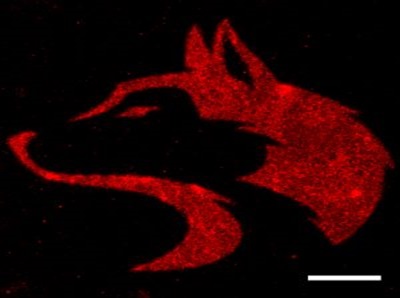Photopatterning of Hydrogel Biomaterials
The solution is a generalizable and intuitive strategy using lasers to print 3D non-discrete patterns across cellular scales in biomaterials.

What is the Problem?
Hydrogel biomaterials are regularly used in three-dimensional (3D) cell culture and tissue engineering applications, but natural protein-based gels have lagged behind synthetic alternatives in terms of their tunability. Although synthetic polymer-based gels have superior patterning ability, natural protein-based systems exhibit higher biocompatibility and enhanced matrix remodeling. As a result, there is a need to develop methods to enable user-defined patterns in natural hydrogel biomaterials.
What is the Solution?
The innovative solution is a generalizable and intuitive strategy using lasers to print 3D non-discrete patterns across cellular scales in biomaterials. Through grayscale image z-stack-guided multiphoton optical-lithography, or GIZMO, a user can input grayscale image z-stacks which will then be photopatterned into the biomaterial via continuous raster scanning of lasers. For ease of use, GIZMO is open sourced and compatible with leading commercial and homebuilt multiphoton microscopes. GIZMO allows for dynamic gel customization at high resolutions and speed and can be used to guide advanced cell fates and engineer functional heterogenous tissues.
What is the Competitive Advantage?
The competitive advantage of this innovation lies in its ability to enable highly customizable gel photopatterning at cellular scales in natural biomaterials. Using GIZMO to create micropatterns in biomaterials will prove useful in engineering vascularized tissues, fabricating next-generation microfluidic devices, and other applications that require precision and microstructural control. By offering the ability to replicate tissue’s innate physiochemical complexity and other complex patterns, this technology can help accelerate research and development in the tissue engineering market. In 2023, the global market for tissue engineering is estimated to be at $13.7M with an expected CAGR of 11.4%.
Patent Information:
-
expand_more mode_edit Authors (1)Cole DeForest
-
expand_more library_books References (1)
- Batalov, I., Filteau, J. R., Francis, R. M., Jaindl, G., Orr, L., Rapp, T. L., Yang, S., Filteau, J. A., Xie, W., Bretherton, R. C., Glaser, A. K., Liu, J. T. C., Stevens, K. R., DeForest, C. A. (2024), Grayscale 4D Biomaterial Customization at High Resolution and Scale, bioRxiv
-
expand_more cloud_download Supporting documents (0)